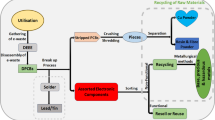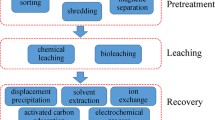Abstract
Over the past several years, considerable efforts have been made to evaluate two novel solution treatment and electrowinning technologies. These two technologies, due to their unique features and superior operating characteristics, could very well represent the next generation of plant practice for the treatment and recovery of metals from liquid effluents. This article reports on the results of using the two technologies to treat printed circuit board spent micro-etch solutions and compares these results with those of competing current technologies for treating similar solutions. The new technologies had about 1.5–10 times higher current efficiencies than current practice and reduced the concentration of metals such as 15 g/L to less than 1 ppm compared to levels as high as 300 ppm again for current practice.
Similar content being viewed by others
References
S. Wang, “Recovering Copper Using a Combination of Electrolytic Cells,” JOM, 54(6) (2003), pp. 51–54.
N. Barr, R. De Denus, and P.A. Treasure, U.S. patent 5,529,672 (25 June 1996).
B.G. Kniazewycz and C.E. Lemon, private communication (November 1999), pp. 1–17.
Author information
Authors and Affiliations
Corresponding author
Rights and permissions
About this article
Cite this article
Wang, S. Novel electrowinning technologies: The treatment and recovery of metals from liquid effluents. JOM 60, 41–45 (2008). https://doi.org/10.1007/s11837-008-0134-8
Published:
Issue Date:
DOI: https://doi.org/10.1007/s11837-008-0134-8




